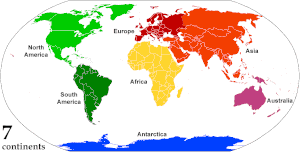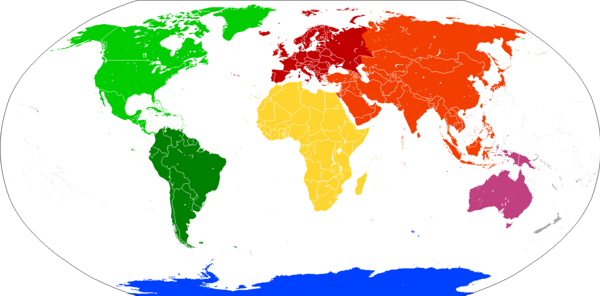මහාද්වීප

මහාද්වීපයක් යනු පෘථිවිය මත ඇති විශාල එකට බැඳුණු භූමි ප්රදේශයකි. දැනට පිළිගැනෙන සම්මතයට අනුව ලෝකය මහාද්වීප 7කට බෙදෙන අතර ඒවා විශාලත්වය අඩු වෙන පිළිවෙලට ආසියාව, අප්රිකාව, උතුරු ඇමෙරිකාව, දකුණු ඇමෙරිකාව, ඇන්ටාර්ක්ටිකාව, යුරෝපය, සහ ඕස්ට්රේලියාව වෙයි[1].
මහාද්වීප ගණන[සංස්කරණය]
මහාද්වීප වෙන්කර හඳුනාගැනීම සඳහා ක්රම කිහිපයක් වෙයි:
බොහෝ විට ඕස්ට්රේලියාව තනි මහාද්වීපයක් ලෙස සැළකුණ ද[2] තවත් සමහරෙක් එය ඕෂනියාව නමැති තවත් මහාද්වීපයක කොටසක් ලෙස සළකති. ඔවුන් පවසන අන්දමට ඕෂනියාවට ඕස්ට්රේලියාව, නවසීලන්තය සහ පැසිපික් දූපත් අයත් වෙයි[3] .
උතුරු ඇමෙරිකාව සහ දකුණු ඇමෙරිකාව එකම මහාද්වීපයක් යැයි සමහරෙක් පවසති. තවත් සමහරෙකුගේ මතය අනුව යුරෝපය සහ ආසියාව යනු යුරේසියාව යන මහාද්වීපයේ කොටස් දෙකකි. යුරේෂියාව සහ අප්රිකාව යුරාෆ්රේසියාව නමැති විශාල මහාද්වීපයක කොටස් දෙකකැයි මතයක් ද පවතියි.

| මහාද්වීප ගණන | මහාද්වීප | මූලාශ්ර | ||||||
|---|---|---|---|---|---|---|---|---|
| මහාද්වීප සතර | Afro-Eurasia (Old World or World Island) |
America (New World) |
Antarctica |
Australia |
[4][5][6][7][8][9][10][11][12][13] | |||
| මහාද්වීප පහ | Africa | Eurasia | America | Antarctica | Australia | [14][15][16][17] | ||
| මහාද්වීප සය | Africa | Eurasia | North America | South America | Antarctica | Australia | [18][19] | |
| Africa | Asia | Europe | America | Antarctica | Australia | [20] | ||
| මහාද්වීප සත | Africa | Asia | Europe | North America | South America | Antarctica | Australia | [18][21][22][23][24][25] |
- The seven-continent model is taught in most English-speaking countries, including Australia,[26] Canada, the United Kingdom,[27] and the United States, and also in Bangladesh, China, India, Indonesia, Japan, Pakistan, the Philippines, Suriname, and parts of Europe.
- The six-continent combined-Eurasia model is mostly used in Russia and some parts of Eastern Europe.
- The six-continent combined-America model is taught in some Romance-speaking countries and in Greece.[20]
- The Olympic flag's five rings represent the five inhabited continents of the combined-America model but excludes the uninhabited Antarctica.[28]
In the English-speaking countries, geographers often use the term Oceania to denote a geographical region which includes most of the island countries and territories in the Pacific Ocean, as well as the continent of Australia.
චීනය, පෝලන්තය, සහ රුසියාව වැනි, සමහරක් ඉංග්රීසි-නොවන භාෂා භාවිතාවන රටවල දී ඕෂනියාව සාමාන්ය මහාද්වීපයක් ලෙස සැලකෙයි. එයට හේතුව වන්නේ "මහාද්වීපය" යන්න සඳහා ඔවුන්ගේ වදන "විශාල භූ ස්කන්ධයක් හා බැඳුන බිමක්" (ඉංග්රීසි landmass යන පදය දෙසට බරව) යන්න වෙනුවට, "දූපත් ද ඇතුළුව ප්රධාන භූමි බෙදීමක්" ලෙස අර්ථ දැක්වෙන (ඉංග්රීසි region යන පදය දෙසට බරව) නිසාය.
ආශ්රිත[සංස්කරණය]
- Boundaries between the continents of Earth
- Dvipa
- Forgotten continent
- List of continent name etymologies
- List of continents and continental subregions by population
- List of sovereign states and dependent territories by continent
- List of transcontinental countries
- Lists of cities
- Mainland Australia
- Subregion
මූලාශ්ර[සංස්කරණය]
- ↑ "Continents: What is a Continent?". National Geographic. සම්ප්රවේශය 2009-08-22. "Most people recognize seven continents—Asia, Africa, North America, South America, Antarctica, Europe, and Australia, from largest to smallest—although sometimes Europe and Asia are considered a single continent, Eurasia."
- ↑ World fact book - Australia, https://www.cia.gov/library/publications/the-world-factbook/geos/as.html#Geo, ප්රතිෂ්ඨාපනය 2010-12-23
- ↑ Worldatlas.com - Australia
- ↑ Dempsey, Caitlin (2013-10-15). "Geography Facts about the World's Continents". Geography Realm. සම්ප්රවේශය 2022-08-26.
- ↑ McColl, R.W., ed (2005). "continents". Encyclopedia of World Geography. 1. Facts on File, Inc.. p. 215. . https://books.google.com/books?id=DJgnebGbAB8C&pg=PA215. ප්රතිෂ්ඨාපනය 26 June 2012. "And since Africa and Asia are connected at the Suez Peninsula, Europe, Africa, and Asia are sometimes combined as Afro-Eurasia or Eurafrasia. The International Olympic Committee's official flag, containing [...] the single continent of America (North and South America being connected as the Isthmus of Panama).".
- ↑ [1] "4 Continents This would probably be the correct subdivision if we adopted a strict definition of continents, ideally defined as large landmasses separated by water. Furthermore, we should consider "separated" only what is naturally separated, excluding therefore the separations resulting from the artificially made Panama Canal (which separates North and South America) and Suez Canal (which separates Africa from Eurasia). Under this model, the four continents of the world are: Afro-Eurasia (or Eurafrasia), America, Antarctica, and Australia (not Oceania, which combines Australia with smaller countries in the Pacific Ocean which are separated by water). An alternative four-continent model, introduced at the beginning of the 20th century, included Europe, Asia, Africa, and America."worldometers
- ↑ "How many continents are there?". Wonderopolis.
If you count Europe and Asia as one continent (called Eurasia), then there are six continents. Some people also count North America and South America as one continent (called America), since the two land masses are separated only by the human-made Panama Canal. This would allow for a model with only five continents.
wonderopolis - ↑ Strobel, Christoph (11 February 2015). The Global Atlantic: 1400 to 1900. Routledge. pp. 13–. ISBN 978-1-317-52552-3.
- ↑ Manual of Modern Geography: 2. William Blackwood. 1870. pp. 18– – via Google Books.
- ↑ Dunn, Ross E.; Mitchell, Laura J.; Ward, Kerry (23 August 2016). The New World History: A Field Guide for Teachers and Researchers. University of California Press. pp. 232–. ISBN 978-0-520-28989-5 – via Google Books.
- ↑ Chatterjee, Sankar (13 March 2015). The Rise of Birds: 225 Million Years of Evolution. Johns Hopkins University Press. pp. 204–. ISBN 978-1-4214-1614-4 – via Google Books.
- ↑ Mackay, Alexander (1861). Manual of Modern Geography: Mathematical, Physical, and Political : on a New Plan : Embracing a Complete Development of the River Systems of the Globe. W. Blackwood and Sons. pp. 15–.
- ↑ Kermack, D. M. (9 March 2013). The Evolution of Mammalian Characters. Springer Science+Business Media. pp. 141–. ISBN 978-1-4684-7817-4 – via Google Books.
- ↑ [2] "In some textbooks, North and South America are combined into "America" and/or Europe and Asia are combined into "Eurasia", for a grant total of 6 or even 5."scienceline
- ↑ Martin W. Lewis and Kären E. Wigen, The Myth of Continents: A Critique of Metageography (Berkeley and Los Angeles: University of California Press, 1997)Wigen
- ↑ [3] "5 Continents This model adopts the criteria of both the six-continent models, resulting in the following 5 continents: Africa, Eurasia, America, Oceania (or Australia), and Antarctica. An alternative five-continent model is the one adopted, among others, by the Olympic Charter, which excludes Antarctica as uninhabited and lists the following five: Africa, Europe, Asia, America, and Oceania (or Australia)."worldometers2
- ↑ [4] "There are even geographical views that prefer the presence of both a Eurasian as well as one American continent. These geographers therefore contend that there should only be 5 continents."universetoday
- ↑ 18.0 18.1 "Continent". Encyclopædia Britannica. 2006. Chicago: Encyclopædia Britannica, Inc.
- ↑ "Continent". The Columbia Encyclopedia. New York: Columbia University Press. 2001. 2 February 2007 දින මුල් පිටපත වෙතින් සංරක්ෂණය කරන ලදී. – via Bartleby.
- ↑ 20.0 20.1 [5] Older/previous official Greek Paedagogical Institute 6th grade Geography textbook (at the Wayback Machine), 5+1 continents combined-America model; Pankosmios Enyklopaidikos Atlas, CIL Hellas Publications, ISBN 84-407-0470-4, p. 30, 5+1 combined-America continents model; Neos Eikonographemenos Geographikos Atlas, Siola-Alexiou, 6 continents combined-America model; Lexico tes Hellenikes Glossas, Papyros Publications, ISBN 978-960-6715-47-1, lemma continent (epeiros), 5 continents model; Lexico Triantaphyllide online dictionary, Greek Language Center (Kentro Hellenikes Glossas), lemma continent (epeiros), 6 continents combined-America model; Lexico tes Neas Hellenikes Glossas, G.Babiniotes, Kentro Lexikologias (Legicology Center) LTD Publications, ISBN 960-86190-1-7, lemma continent (epeiros), 6 continents combined-America model
- ↑ World, National Geographic - Xpeditions Atlas. 2006. Washington, DC: National Geographic Society.
- ↑ The World - Continents සංරක්ෂණය කළ පිටපත 21 පෙබරවාරි 2006 at the Wayback Machine, Atlas of Canada
- ↑ The New Oxford Dictionary of English. 2001. New York: Oxford University Press.
- ↑ "Continent සංරක්ෂණය කළ පිටපත 28 ඔක්තෝබර් 2009 at the Wayback Machine". MSN Encarta Online Encyclopedia 2006.. 31 October 2009.
- ↑ "Continent". McArthur, Tom, ed. 1992. The Oxford Companion to the English Language. New York: Oxford University Press; p. 260.
- ↑ "F-10 Curriculum Geograph". Australian Curriculum, Assessment, and Reporting Authority. 24 March 2014 දින මුල් පිටපත වෙතින් සංරක්ෂණය කරන ලදී.
- ↑ "National curriculum in England: geography programmes of study". UK Department for Education.
- ↑ "Preamble" (PDF). Olympic Charter. International Olympic Committee. 17 July 2020. p. 10. සම්ප්රවේශය 3 August 2021.
the five interlaced rings, which represent the union of the five continents












